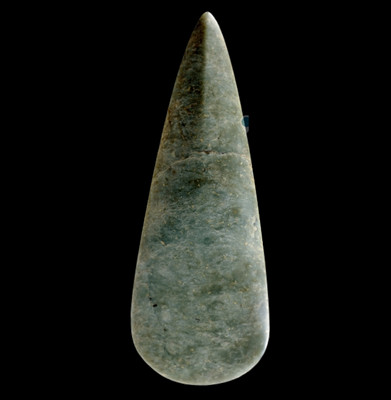At first sight our axe looks like thousands of others in the British Museum collection, but it's thinner and it's wider than most of them. I'm holding it now very carefully, because it still looks absolutely brand new-and very sharp. It's the shape of an oversized tear drop-about seven inches long and at the base about two or three inches wide. It's cool to the touch and extraordinarily, pleasingly, smooth.
第一眼看過去,這把玉斧看起來就像大英博物館館藏的成千上萬其他斧子一樣,但相比這絕大多數(shù),它顯得更薄,更為寬闊。我現(xiàn)在非常小心地握著,因為它看起來仍然是嶄新,而且非常鋒利。它的形狀好似一個超大號的淚珠—約7英寸長,底部約兩至三英寸寬。摸起來很酷而且感覺令人異常愉悅,光滑。
Axes occupy a special place in the human story, the farming revolution in the Near East took generations to spread across the breadth of mainland Europe, but eventually, about six thousand years ago, settlers reached British and Irish shores in skin-covered boats, bringing with them crop seeds and domesticated animals. They found thick forests covering the land. It was the axe that enabled them to clear the spaces they needed to plant their seeds and graze their beasts. With axes the settlers made for themselves a new wooden world: they felled timber and built fences and trackways, houses and boats. These were the people who would also construct huge, mysterious monuments like the first Stonehenge. Stone axes were the revolutionary tool that enabled our ancestors to create a green and pleasant land.
斧子在人類歷史中起到非常特殊的作用, 近東農(nóng)業(yè)的革命經(jīng)過世代演變蔓延到歐洲大陸,但最終,大約6000年前,移民依靠皮毛船只抵達(dá)英國和愛爾蘭海岸,隨之而來的還有農(nóng)作物種子以及家畜。他們發(fā)現(xiàn)濃密的森林覆蓋這片土地。于是斧頭幫助他們清除他們播撒種子及放牧野獸所需的空間。定居者們還依靠斧子為自己創(chuàng)造了全新的木制世界:他們砍伐木材,建造柵欄,道路,房屋和船只。這些人也建造巨大的神秘遺跡和第一座巨石陣。石斧是革命性的工具,使我們的祖先能夠創(chuàng)造綠色且適宜人類生存的土地。












